
By Nazim Malik
(Pak Destiny) Express media group of Sultan Lakhani has declared war on Dawn media group of Hameed Haroon to expose property tycoon Malik Riaz regarding illegally occupying the state land in Sindh.
Sultan Lakhani’s action may bring bad name to his media house
Perhaps this is one of the dirtiest example as how media groups are being used against the one that is exposing fraud of big fish.
This never happens elsewhere
This seems to happen only here. One asks the Express Tribune to tell why it felt the need to run over 1,000 words story on its front page clarifying that Malik Riaz is the most honest man and what Dawn has written is absolute lie. What a shame for Lakhani to go to this extend to protect Bahria Town owner.
This is the power of Malik Riaz
Lakhani could have supported Riaz in million other ways but this is so terrible to see his declaring open war on rival media group for exposing the land grabbing mafia that is known for obliging media group owners, journalists and anchors.
The Committee to Protect Journalists should take note of this.
Read here both stories about Bahria Town by Dawn and Express Tribune

Unsatiated greed of anti-development mafia
KARACHI: It was a settled matter until two days ago – settled by none other than the Supreme Court of Pakistan. But on Sept 12 & 13, an English-language daily tried to rake up old allegations against Bahria Town Karachi (BTK) in an attempt to resurrect controversies against the mega project which has set in motion a huge economic activity in the metropolis.
The two-part report flashed across the front page of the newspaper, based on a rehash of old allegations and accounts of some fictitious characters, led The Express Tribune to probe into the matter. And what transpired turned out to be contrary to facts and part of a smear campaign against the BTK – Asia’s largest private real estate developer.

PHOTO: EXPRESS
The timing of the report is telling. It came at a time when the national economy – which is not in a good shape – direly needs a fillip. And construction industry has the wherewithal to do just that. Construction of quality housing and infrastructure holds the key to economic turnaround. People opposed to such projects, especially those involving world class schools, colleges, hospitals, malls, markets, etc, are in fact opposed to development in Pakistan.
“Bahria Town Karachi is a whole new world – away from the cacophony of the teeming city whose infrastructure is in a shambles. It’s a modern project which not only provides world class housing, but also provides amenities beyond the basic requirements,” Shakeel Ahmed, a resident in the project, off Superhighway said while talking to The Express Tribune.
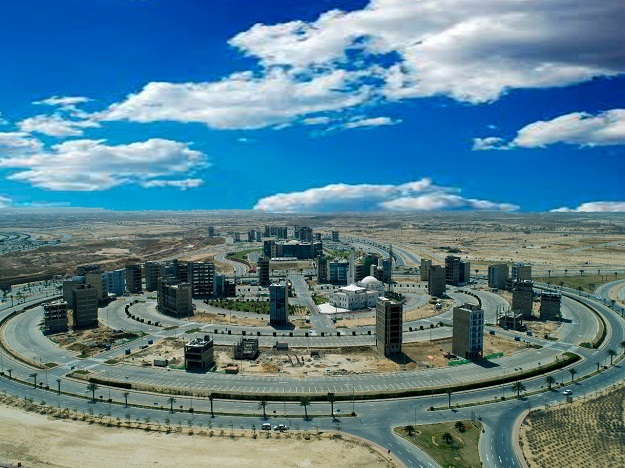
PHOTO: EXPRESS
“It’s an oasis of modernity on the edge of a city which is rapidly caving in to its ever-growing population,” says another resident Tauseef Khan. “Bahria Town not only houses the world’s third largest mosque, but is also home to state-of-the-art hospitals, quality educational institutes, and dazzling shopping malls and markets.
Apart from meeting the housing needs of the growing population – that too in a quality way, BTK has also created employment opportunities for thousands of people – from labourers to engineers – who are working on the sprawling project on 16,896 acres of land off Superhighway.
Referring to the news stories about BTK in the English-language daily, most residents interviewed by The Express Tribune said such baseless reports were an attempt to stymie development work in Pakistan in general and in Sindh in particular where investment in development is badly needed.
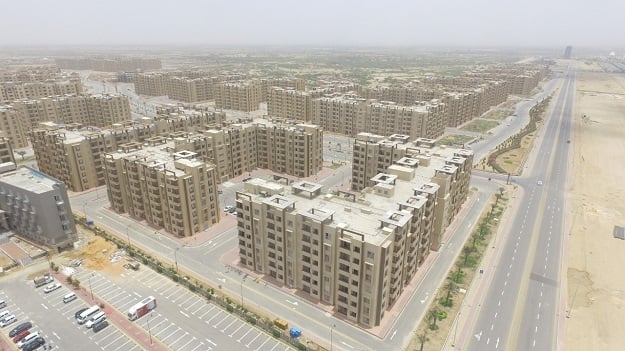
PHOTO: EXPRESS
This mega project is doing what the cash-strapped government has been unable to do: overcome the shortage of housing units in Pakistan. At the same time, this project has also convinced people to invest in Pakistan’s real estate sector instead of taking their money out of the country and investing in Dubai and other developed countries.
According to official stats, Pakistan is currently facing a shortage of over 10 million housing units. Bahria Town Karachi is estimated to accommodate as many as 150,000-200,000 families of an average 5 to 6 people each.
The mega project has not only provided job opportunities to around 70,000-80,000 people for several years, but has also given a massive boost to around 70 construction and allied industries which is a must for much-needed acceleration in economic activities.
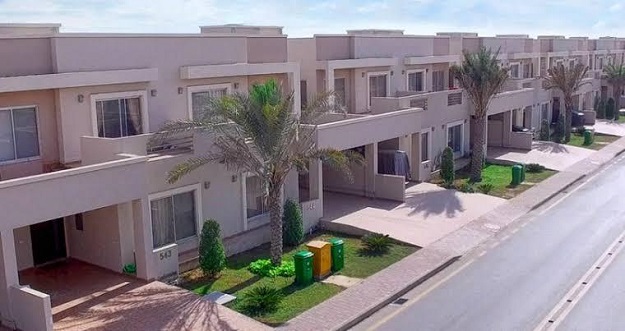
PHOTO: EXPRESS
Officials have sought to debunk legal controversies around this project. “Bahria Town Karachi has fulfilled all legal requirements for acquisition of land (16,896 acres) from local residents,” an official of the Malir Development Authority, told The Express Tribune while speaking on the condition of anonymity.
“If the allegations of coercion and intimidation have any truth to them, then there would have been some FIRs in police stations or cases in the court of law against the developer,” he said. “There is no police case – no FIR, no litigation from anyone who sold out his land to the developers.”
“If allegations of coercion were true, then our ubiquitous media would have reported cases of intimidation of land sellers at the hands of influential,” he said while asking: “Have you seen any such report in the media?”

PHOTO: EXPRESS
There have been no reports of bulldozing of houses, desecration of graveyards; baton charging of protesters, or riots in the area. “This is because the locals had sold out their lands and got the demanded price,” the official said. The charges of coercion are the figment of someone’s imagination.
Referring to the process of land acquisition, the official said a number of government offices and departments are involved in the transfer of land from the seller to the buyer, including the Malir Development Authority MDA itself, Land Utilization Department, Deputy Commissioner (DC) Revenue, and the Board of Revenue, Government of Sindh.
Advertisements were placed in newspapers for the land transaction before it was physically transferred from the seller to the buyer. They transferred the land after an advertisement campaign spanning over several weeks – and no one came forward to make claims. “The doors of district courts, civil courts, sessions courts, high court and the Supreme Court are open. If someone is having a complaint, they should go any court of law,” he said. These allegations against Bahria Town Karachi reek of mala fide intent, he added.

PHOTO: EXPRESS
The official said some local influential, Waderas, in the area were trying to blackmail the developers into giving them commissions and threatening them with smear campaigns. They continue to create hue and cry and propaganda against the project for ulterior motives.
He recalled that the Bahria Town Karachi’s matter was finally settled by the Honourable Supreme Court in March 2019, following which development work resumed.
“The Supreme Court accepted the Bahria Town Karachi offer of Rs460 billion in the case and allowed it to go ahead with the project,” he recalled.
However, some miscreants are not happy with the Supreme Court ruling and want the project owners to pay them in cash and kind, he said, while explaining the latest smear campaign against the mega project.
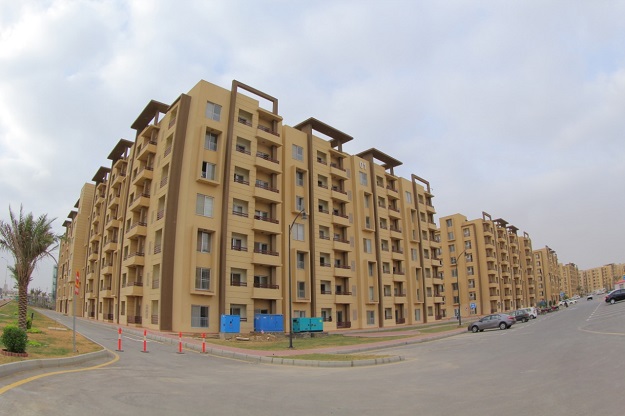
PHOTO: EXPRESS
The Supreme Court decision in the Bahria Town Karachi case provided a huge relief to thousands of people who have invested millions of rupees from their life savings in the project. Biased reporting about this project would only jeopardise their savings.
“This is a huge project [worth trillions of rupees]. The decision would help boost economic activities as construction [sector] and dozens of allied industries [like cement, steel, labour, contacting companies, paint, electrical and electronic goods etc.] play significant role in GDP growth,” renowned businessman Arif Habib said on the day the apex court had given its verdict.
“Now, the decision should improve business sentiment and investors in the project would feel relieved because of the resumption of work on the projects.”
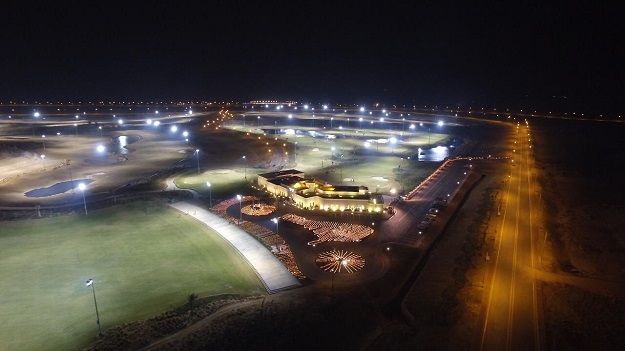
PHOTO: EXPRESS
Another noted businessman, Aqeel Karim Dhedhi, said that the Supreme Court decision provided relief to thousands of people who had invested around Rs2 trillion in the project. He added that this decision would improve economic and business activities in the country.
According to Dhedhi, a halt to construction activities at the project site made construction and allied industries dead while the overall business sentiment in real estate and property sector went negative. “This increased unemployment and crimes,” he said.
“The Supreme Court decision now changes the sentiment to positive and provides job opportunities. This will also make investors, builders and developers happy and energetic. This is win-win situation for all the stakeholders in the project,” Dhedhi added. “It is win-win situation for everyone including, genuine buyers, local investors, non-resident Pakistani and other overseas investors.”
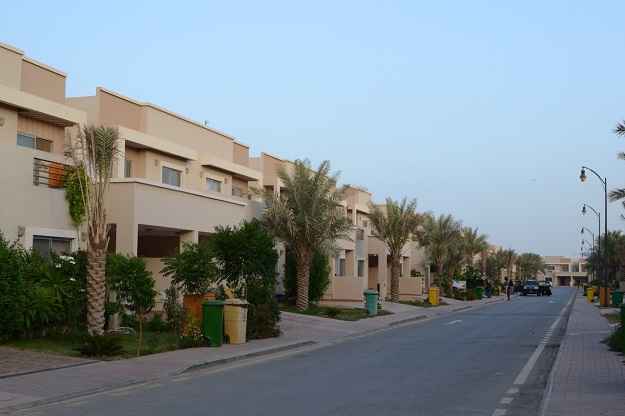
PHOTO: EXPRESS
The Malir Development Authority said all legal formalities had been completed by the developers for Bahria Town Karachi. “They acquired land at Superhighway for the project in the manners Pak Fazaia and Pakistan Navy have acquired land for their respective projects,” the official said.
Another official at a government office said that Bahria Town Karachi has continued to construct the project through legal means as it did not use sand, gravel and water from Mole Naddi as has been alleged in the report. With the technology available, anyone can superimpose any construction equipment on any satellite drawings or maps, he added.
“Bahria Town Karachi has constructed 16 dams within the vicinity of the project. The dams accumulate and store rainwater which is later used for construction,” he said.
Besides, the project has also used treated sewerage water for plantation, he said.
“The sand and gravel being used in the project is brought from Jamshoro and Nooriabad on trucks,” he said. This is a matter on record and can be verified.
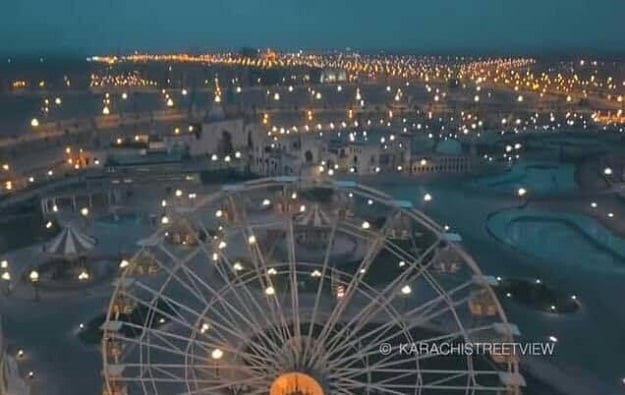
PHOTO: EXPRESS
Ghulam Abbas, who is from Swat and drives truck to transport sand and gravel to Bahria Town, said he and his fellow truckers had never transported sands and gravel from Mole Naddi, but from other parts of the city.
“Gaddap town police is so strict. They never allow transportation of sands from Mole naddi to anywhere. Therefore, they have to go extra miles to bring the construction material to Bahria Town,” he said.
The official said Bahria Town Karachi is a commercial project. Why the owners would make it controversial through involving in illegal ways of construction when they know what is good for the project.
The official said Bahria Town did not expand construction of the project by an inch beyond the limits allowed by the Supreme Court in the recent past.
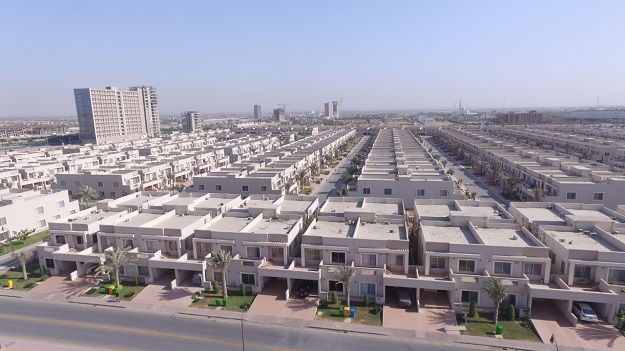
PHOTO: EXPRESS
He wondered why questions were being raised about the Bahria Town Karachi project while the Supreme Court has allowed resumption of construction in March 2019.
A resident Ghulam Ali Gabol said he had sold the land back in 2014. “The land was lying for nothing for many years. The amount received against the sale of the land was partially utilised to buy a home for my family and I parked the remaining amount in a fixed deposit scheme in a bank. The bank is paying profit against the amount per month,” he said.
He said he was not alone who had sold the land, but he knew several people who sold their land in need of money to Bahria Town. “A couple of people were initially not interested in selling their land, but later decided to sell keeping in view the attractive offer,” he said.
Rasool Bux, a resident in the neighbourhood of Bahria Town Karachi, wished to have basic amenities like shelter, schools and hospitals like people enjoy in Bahria Town project. “I have heard people in Bahria Town are having best of the best amenities inside the project.”
He said they have schools and hospital buildings in the area, but they do not provide quality services. He asked authorities concerned to learn something from Bharia Town and provide them basic facilities in the area.
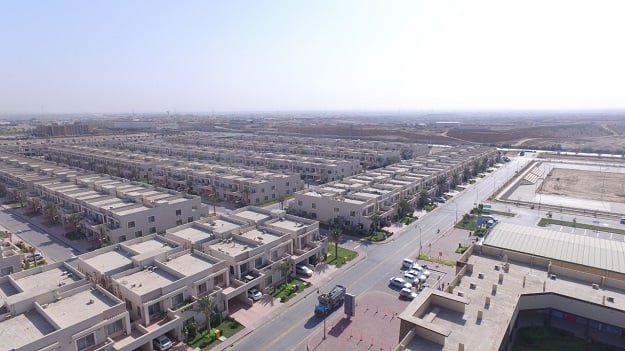
PHOTO: EXPRESS
The area people said they had no issues with the Bahria Town project in their neighbourhood. Rather, they were happy that the project has lifted price of their lands manifolds.
“The Bahria Town project would convince authorities concerned to increase the quality of services in the time to come as it is almost impossible that the people of the area continue to live with poor facilities,” said one resident.
HERE IS DAWN STORY ON BAHRIA TOWN

Bahria Town & others: Greed unbound
Land grabbers continue their loot and plunder on Karachi’s outskirts. Only this time, the process is far stealthier. Naziha Syed AliUpdated a day ago The villagers were terrified, afraid their identities may be revealed by this story. It took weeks to convince them to share with Dawn, in confidence, their experiences of being pressured to surrender their land in Jamshoro district in the service of ever-expanding housing communities off Superhighway. “If our sardar finds out we’ve talked to anyone about this, the police will beat us and throw us into the lock-up for days on end,” said Anwar Burfat. He was among a group of goth residents who agreed to speak with Dawn at a restaurant close to Safoora Goth roundabout.
Over the last few years, as revealed in an earlier investigative report in this paper, the indigenous Sindhi and Baloch communities in Malir district were strong-armed into ‘selling’ their land — which they had lived on and cultivated since generations — for Bahria Town Karachi (BTK). They were relentlessly hounded by a two-pronged assault. On the one hand, the Malir police, under SSP Rao Anwar at the time, carried out raids on the goths and booked locals on fake terrorism charges; on the other, Bahria personnel, including a retired colonel, constantly threatened and intimidated them. Meanwhile, in Karachi’s Tauheed commercial area, real estate agents sold registration forms for Bahria’s ill-gotten land like hot cakes. A farmer working on his patch of land in Malir district. – White Star
This story, a sequel to the previous one on April 18, 2016, is about how the state’s failure to protect indigenous communities and punish the perpetrators of ‘land grabs’ is resulting in a further hollowing out of the governance system. Dawn’s investigations indicate that Bahria Town in connivance with Sindh government functionaries is continuing to acquire thousands of acres of land in district Jamshoro, adjacent to district Malir, albeit in a more indirect manner than it earlier employed.
This time around, aside from the old cast of land grabbers and dirty cops, there are ruthless feudals and their henchmen playing a pivotal role in what may well be the biggest scam in Pakistan.
At the time of Dawn’s earlier story, satellite images, site visits and interviews with locals had established that BTK was being developed over 23,300 acres in district Malir, the green belt of Karachi. On May 4, 2018, a three-judge bench of the apex court in a majority judgement held Bahria Town guilty of illegally acquiring thousands of acres of land in Malir for its Karachi housing project. It termed the acquisition “void ab initio”, meaning null and void from the outset, and castigated the Board of Revenue Sindh (BoR) and Malir Development Authority (MDA) for their role in the scam.
However, it issued some directions to address the third party interest created on the stolen land and ordered that a three-judge bench be appointed to implement its ruling “in its letter and spirit”. Many consider the ruling by the implementation bench on March 21 this year to have overlooked some important aspects of the original judgement. A small farm on the left in the path of the advancing Bahria Town. – White Star
What is certain is that neither SC bench gave Bahria permission to expand its housing project further. In fact, the March 21 verdict categorically said: “BTLK [Bahria Town Limited, Karachi] has no right, title, interest or possession of any other land owned by the Government of Sindh other than 16,896 acres…The government of Sindh and the MDA shall ensure that any land beyond this stands retrieved and no excess land shall be allowed to be occupied by BTLK. Any violation of this direction shall entail criminal action both against the functionaries of government of Sindh, MDA and the management of BTLK or whosoever is found responsible.”
Dawn’s investigations indicate that Bahria Town in connivance with Sindh government functionaries is continuing to acquire thousands of acres of land in district Jamshoro, adjacent to district Malir, albeit in a more indirect manner than it earlier employed.
The Supreme Court proceedings in the BTK case that concluded in March dealt with the exchange and consolidation of land in district Malir.
But there are clear signs of expansion into district Jamshoro, although the manner in which this land for expansion is being acquired remains a mystery. Satellite imagery from January 2019 to July 2019 shows that not only has BTK’s construction extended well inside deh Mole, taluka Thana Bhula Khan, district Jamshoro but that the construction is ongoing. Bahria Town’s title to land in Jamshoro merits investigation.

An overlay of satellite images from January 2019 to July 2019 showing fresh work on Bahria Town’s road network in district Jamshoro. Satellite image source: Planet; Map details by Dawn GIS
Further inside Jamshoro, there is more damning evidence of criminal wrongdoing by the land mafia and the Sindh government — those details are in the second part of this story: A disaster foretold.
‘King of Kohistan’
In district Jamshoro, which adjoins Malir, the absolute power of a regressive feudal structure determines every aspect of life. This area is part of what is colloquially known as Kohistan (comprising Jamshoro and Hyderabad districts, as well as portions of Karachi’s Malir and West districts). Sardar Malik Asad Sikandar, PPP MPA from Jamshoro is one of the most influential feudals in Sindh. He is chief of the Burfat tribe; with around 100 sub-tribes, it is the biggest of the four tribes in Kohistan. Each tribe has its own sardar, but — and this is why Malik Asad is known as the ‘King of Kohistan’ — he is the ‘sardar of sardars’.
With huge landholdings in various parts of Sindh, Malik Asad allegedly has a stake in the many housing societies being planned along Superhighway and draws a steady stream of ‘revenue’ from business and industrial activities within ‘Kohistan’. The area also has a sizable Hindu population, including several owners of rice mills and cotton ginning factories. Many of them also own liquor shops. According to a local journalist, they have “strong linkages and friendships” with Malik Asad and “are at his beck and call”. Malik Asad with Malik Riaz at the inauguration of the Grand Mosque inside BTK. ─source
Powerful connections are also forged through hunting expeditions hosted by Malik Asad in Kohistan for Arab royalty and assorted members of the Pakistani elite — including at least one retired judge. His own men — who include game wardens and wildlife inspectors from the Sindh Wildlife Department — provide security and facilitate the hunting of not only small game but, in the case of the Arabs, also ibex and the endangered houbara bustard. “No one can hunt without the sardar’s permission anywhere in Kohistan,” said a local who has worked in the wildlife sector for 13 years. He described the camps of the Arab hunting parties as huge, accommodating at least 100 people at every meal, adding with a laugh, “Everything conceivable is provided for them”.
Below Malik Asad in the feudal hierarchy are waderas who head the sub-tribes; below them are the lesser waderas, locally known as kumdar, one in each village. Anyone who challenges this social order is dealt with ruthlessly. The kumdar reinforce the writ of the sardar at the village level, acting as his eyes and ears on the ground. It is a hereditary occupation of sorts, with their fathers and grandfathers having done much the same before them.
The police are a vital link in this chain of oppression. “Let alone the local SHO, even the DSP stands with hands folded in his presence,” said Aziz Burro, a young farmer with a disgruntled expression. “Anyone earning the kumdar or local wadera’s displeasure is picked up in false cases of theft or drug possession and thrown into the lockup for a few days or sent to prison. Can you imagine what it’s like for his family to go to Kotri 100kms away to try and obtain bail?”
Another goth resident narrated the following incident. “About two years ago, when one farmer in deh Rek insisted he had the right to extract minerals found beneath his land [the area is rich in mineral deposits], his pick-up was set on fire and he found himself in the thana. The police showed his arrest as having taken place in Balochistan and charged him with transporting illegal weapons from Durreji. He was in Gadani jail for several months before he got bail.”
Malik Asad, however, refuted such allegations, saying: “We’re here to solve any issue that the people face. We wouldn’t allow any ziyadati to be done with them.”
According to a police officer who has served in Jamshoro, “Usually, police officials here call on him [Malik] off and on during their posting but I didn’t ever go to see him at his home and [for that reason] he complained about me to a senior political person.”
But there are limits even to the tribal chieftain’s enormous power. That became evident when Bahria made known its intention to acquire land in Jamshoro a few years ago. (During the proceedings before the SC’s implementation bench, it came to light that the real estate developer had already acquired several acres in the district).
While Bahria told Dawn that details of its land acquisition in Jamshoro had been shared with the Supreme Court, it did not respond to any other queries put to it by Dawn.
Some say that Malik Asad was loathe to accede to Bahria’s demand, while others allege that in exchange for the land, Malik Asad wanted to drive a hard bargain with the political bosses of the Sindh government who are allegedly partners in BTK. Whatever the case, he was soon made to realise the rules of the game were decided elsewhere.
Differences between Malik Asad and PPP co-chairperson Asif Ali Zardari came to the fore some time in 2017. It is believed the tribal chieftain demanded a price for some 5,000 acres of land in deh Mole in Jamshoro that Malik Riaz, owner of Bahria and Mr Zardari’s close associate, was not willing to pay. In the words of a local contractor, “Malik Riaz went and complained to Zardari that this man is giving me grief all the time. Baray saeen became furious with the sardar”.
(An excerpt from the JIT report investigating the fake accounts case reads: “Bahria Town was recipient of huge acreage of state land for BTK and was occupying huge tracts of adjacent private land with the connivance of government of Sindh. Hence, the Rs10.02 billion was a kickback, Rs8.3bn of which was paid by Bahria through a joint account with Mushtaq Ahmed, confidante of Mr Asif Ali Zardari.”)
According to a source in the Sindh government, an SSP was appointed for district Jamshoro on Malik Riaz’s say-so specifically to strong-arm Malik Asad.
Suddenly, Malik Asad found his dhikkas (sand mining sites) in Lonikot being closed down. Various business activities in Kotri in which he was a beneficiary were disrupted. The landscape of Malir and Jamshoro is being irrevocably altered by Bahria Town. – White Star
Some of Malik Asad’s friends in the construction business, such as Arbab Samoo, saw their housing societies along Superhighway, such as Educators Valley, Education City and Jamshoro City partially demolished by the Sindh Building Control Authority (SBCA) in late July. As they were built on land considered to be part of his fiefdom, Malik Asad is said to be a stakeholder in some of those businesses and societies. A civil suit filed by Mr Samoo is pending in the district court.
On top of that, the PPP’s senior leadership started sending out feelers to Malik Asad’s paternal cousin and political rival Malik Changez (even though Changez is affiliated with the PML-N while Malik Asad was PPP MNA from Jamshoro at the time).
According to several sources, it didn’t take long for Malik Asad to come to his senses. “He dashed to Dubai and fell at Zardari’s feet,” said a political activist in Malir. “But even today, the PPP continues to dangle Malik Changez like a sword over Malik Asad’s head in order to control him. When Zardari falls out with someone, he never forgives them. Many Tappis have come and gone.”
That Mr Zardari and Malik Asad’s relationship remains strained is clear. “No protest of note took place in Kotri after Asif Zardari and Faryal Talpur’s arrest,” said a Hyderabad-based journalist. “Only a few people came out on the road. Normally there would have been a big turnout”.
‘Please help us’
Meanwhile, the villagers who depend on barani (rain-fed) agriculture, poultry farming or livestock rearing in the area are being driven towards financial ruin. “We wanted to get our land regularised so it wouldn’t be so easy to grab it. But the sardar ordered us not to, saying ‘do you want me to suffer the same fate as Zulfiqar Mirza?’ When our own sardar isn’t backing us, what can we do?” said one local helplessly. Against the backdrop of their despair, Bahria’s replica Eiffel Tower looms in the distance. Bahria’s replica Eiffel Tower looms over the landscape. – White Star
When asked by Dawn, Malik Asad denied that any procurement of land is happening. “There’s been no activity since at least one year, absolutely none.”
However, unlike the land grab earlier, the modus operandi this time around is far more opaque, with several tiers of frontmen between the ‘seller’ and the actual beneficiaries.
The local administration and revenue officials collude in identifying the land to be procured — most of the area is state land with some pockets of maroosi (ancestral) land — and tampering with the records. Using threats and intimidation, kumdar procure the villagers’ land and brokers prepare falsified documents; the land is then sold to frontmen of massive housing projects in the area.
Malik Nadir, a close relative of Malik Asad and a major landowner himself, named Zain Malik and Malik Akhtar, both of Bahria Town, and told Dawn on the record that they “are purchasing land and papers in deh Sari [also in district Jamshoro] and deh Mole. DC Jamshoro is the helping hand. They are buying it for Bahria Town expansion. Buying and selling of land is prohibited in that area. They are doing it illegally”.
In a letter that Malik Nadir wrote to NAB last year, which he has shared with Dawn, he asked that an investigation be conducted into the actions of several individuals including, among others, Faryal Talpur, mukhtiarkar Thana Bhula Khan Mansoor Kalhoro and Malik Changez Khan. The letter reads: “The above cited persons mutually made huge corruption in shape of false record of rights, issuance of false sale certificate, and kept bogus entries of 10,000 acres of above dehs…[Babar Band, Hathal Buth, Kalo Kohar and Mole, all in district Jamshoro].” He has recently updated Dawn that “they have completed their target in Mole, have bought almost 10,000 acres of land there. No more purchasing is being done there”.
The villagers who depend on barani (rain-fed) agriculture, poultry farming or livestock rearing in the area are being driven towards financial ruin. “We wanted to get our land regularised so it wouldn’t be so easy to grab it. But the sardar ordered us not to, saying ‘do you want me to suffer the same fate as Zulfiqar Mirza?’
There are several kumdar in the area: however, in conversations with goth residents, a few names repeatedly cropped up as being among those most active in the land grab. Another individual, who lives in Gadap, is described by the villagers as “the head of the qabza cell”. All of them have acquired enormous wealth through work as low-level operatives for the land mafia, as well as from running other criminal rackets in the area, details of which can be found in Part 2 of this story, A disaster foretold.
According to a local rights activist, aside from the bigger zamindars, others aren’t giving up their land willingly. “They don’t know anything else but agriculture and livestock rearing. Where will they go?”
Not all the bigger zamindars want to sell either. When the wadera of Musa Chhoro goth, Pinni Laddo Chhoro, along with several others went to another, more influential, tribal chieftain to plead their case in person, he was sent packing.
Several villagers in district Jamshoro reveal they are being, or have been, coerced to surrender their land at Rs70,000 per acre. (Consider that back in 2007, 120 square yard plot in Taiser Town, Malir, was selling for Rs120,000. At that rate, even then, 12 years ago, one acre of land in the area now affected would be worth Rs4,000,000!)
The land ‘sold’ by the villagers is then purchased by individuals fronting for massive land developers in the area at Rs2,000,000 per acre, an astronomical 2,757 per cent increase. The figures were confirmed to Dawn by a local broker. In many cases, even the pittance promised to the owners has not fully materialised.
With 4,840 sq yards to an acre, Rs2,000,000 works out at approximately Rs400,000 per 1,000 sq yards. Further, to gauge the eye-watering fortunes being raked in, consider that the price of a 1,000 sq yard plot in Bahria’s Sports City — which currently extends at least up to the boundary of Malir’s deh Bolari where it meets district Jamshoro’s deh Mole — was Rs9,200,000 plus at the time of balloting in 2016. That’s another 2,200pc gain.
According to the locals, the land bought from them is being ‘shifted’ closer to lie alongside already developed housing projects, to enable them to expand further. “This time the land developers are not making the mistake of consolidation, which exposed Bahria badly the last time,” says an academic belonging to the area. However, when contacted, DC Jamshoro retired Capt Fariduddin Mustafa, said: “No recent land transaction has taken place, although some private people may be selling or buying land.” (The DC, appointed by the provincial government, heads the revenue and land administration in a district.) Map of Bahria as presented to the Supreme Court by BoR Sindh. The image appears to be the latest one on Google Earth Pro, which dates back to December 2017.
Sajid Chhoro is a local broker who understands the modus operandi like the back of his hand. “Most of the land in deh Mole is unsurveyed; the survey numbers are for small areas of max two acres each. They’re taking the khaatas [a khaata is an assessment of a property, including size and owner’s name, in the land record] and shifting them along with a chunk of surrounding state land. For example, if they take a 10-acre khaata, they’ll show it as 100 acres in the record and place it over land near Bahria.” Then he leans in and asks: “How do you think all the khaatas of deh Mole are now in one corner?”
In short, from numerous interviews of Jamshoro locals, it appears that government land is being illegally procured under the guise of private transactions.
Meanwhile, the digitised land record in the Sindh government’s much-vaunted Land Revenue Management Information System has mysteriously been inaccessible since months. This fortifies the claims made by those cited above, and calls for an investigation.
NAB investigations
Let us turn now to the most well known land grab in the area. For years, NAB dragged its feet in the SC case against Bahria Town. A source in the organisation told Dawn back in 2016: “You have no idea how much pressure we’re under to not move on this.” However, the three-judge apex court bench hearing the case finally managed to prod the anti-corruption watchdog into investigating the shenanigans behind BTK.
During the hearings of the bench set up by the SC to implement its May 4, 2018 judgement, NAB submitted several confidential progress reports to the court.
The contents of these reports are an eye-opener: they reveal, among many other things, Bahria’s contempt for any institutional effort to throw light on its activities.
An excerpt from NAB’s second report, dated Nov 19, 2018 — a copy of which is in Dawn’s possession — and signed by Qamar Abbas Abbasi, Deputy Director/Investigation Officer, NAB Karachi, reads: “It is also submitted that the CEO Ali Ahmed Riaz Malik…and the above named 5x frontmen of BTPL [Waseem Riffat, Waqas Riffat, Shahid Mehmood, Mohammed Awais and Faisal Sarwar] have never joined instant investigation, despite issuance of several call-up notices. The recent call-up notices issued to the known addresses of said 5x frontmen were returned undelivered.”
The March 21, 2019 verdict of the SC’s implementation bench accepted Bahria’s offer of Rs460 billion as land settlement dues to be paid over seven years.
An inexplicable aspect of the implementation bench’s order was its direction to NAB not to file any references against Bahria “for the time being” unless there was any default in making payments or violation “in any of the terms and conditions mentioned…”. This appears to contradict the May 4, 2018 judgement that had ordered NAB to complete its investigation within three months and initiate proceedings in the accountability court against all those guilty of causing loss to the state exchequer.
According to sources in NAB, an investigation was conducted in Case No NABK2016010138803 whereby 34 people were named as accused in connection with “illegal adjustment/exchange/consolidation of thousands of acres of state land in multiple dehs of district Malir for the purpose of development of a private project.”
The names include (in chronological order) Malik Riaz, his son Ahmed Ali Riaz, son-in-law Zain Malik, wife Bina Riaz, former Sindh chief minister Qaim Ali Shah and former local government minister Sharjeel Memon. The other names are those of 23 government servants belonging to BoR Sindh, SBCA and MDA; among them, former DC Malir Kazi Jan Mohammed, MDA Additional Director Mohammed Sohail and six retired SBCA DGs — including the infamous Manzoor Kaka who, it is believed, has long absconded to Canada. Former secretary local government Javed Hanif, currently in jail on an unrelated charge, is also in the list. Five names are described as frontmen of Bahria Town. A copy of NAB’s investigation report recommending that a reference be filed against former chief minister Qaim Ali Shah.
NAB’s investigation report on Mr Shah notes: “After discussing the role/evidence collected during the course of investigation against ex-CM Syed Qaim Ali Shah in the RBM, it was decided that enough evidence has been available/collected to prosecute him.”
Meanwhile, an interesting situation has arisen as to the status of the land in Malir where BTK is coming up. In its May 4, 2018 judgement, the SC had ordered: “The government land would go back to the government and the land of the Bahria Town exchanged for the government land would go back to Bahria Town…[T]he land could be granted to the Bahria Town afresh by the BoR under the provisions of Colonisation of Government Land 1912.”
(The court was referring here to Bahria Town’s purported purchase of separate pieces of land in distant parts of Malir where land rates are as low as Rs20,000 per acre. MDA then illegally adjusted and consolidated these for Bahria’s benefit in parts of Malir close to Superhighway where land values were up to 50 times higher.)
However, despite the apex court having expressly declared that the exchange and consolidation activities in Malir were “void ab initio and as such have no existence,” BoR Sindh — the rightful owner of the land — has not yet allotted one inch of the area “afresh” to Bahria.
The problem, say sources, is that the court did not clarify how the process of regularisation is to be done. The Colonisation of Government Lands Act 1912 does not provide for a situation where what has been declared illegal can be legalised. Given an environment where NAB is particularly active, this conundrum has left the bureaucracy paralysed. (In fact, a Senior Member BoR, Sindh was recently made OSD because he was reluctant to take on the task lest it put him in legal jeopardy at some point. The current SMBR is Shamsuddin Soomro.)
Even so, the Sindh government made a show of complying with the May 4 verdict. On Oct 29, 2018 the then SMBR Muhammad Hussain Syed chaired a meeting at his office in Karachi. Also present were the secretaries for Land Utilisation and Local Government Departments, as well the DG, MDA and the DC Malir.
According to the minutes of the meeting, it was decided that BoR would cancel/withdraw the orders whereby it had reserved and allotted land in favour of MDA. “…[T]he DC, Malir Karachi upon receiving of order…shall take necessary action as per order of the Honorable SC…”.
Nothing has happened thus far. BoR did not do the necessary paperwork, nor did the DC Malir, Shahzad Afzal Abbasi, assume control over the illegally acquired land. BoR even sent him a reminder to do the needful.
Despite the apex court having expressly declared that the exchange and consolidation activities in Malir were “void ab initio and as such have no existence,” BoR Sindh — the rightful owner of the land — has not yet allotted one inch of the area “afresh” to Bahria.
Both G. N. Mughal, BoR’s legal advisor and Irshad Rind, deputy secretary litigation BoR confirmed there has been no progress in this direction so far. Mr Rind also blamed the DC Malir who he said showed no inclination to take physical possession of the government land in Malir after the May 4 judgement, or halt Bahria’s construction work thereon.
As for MDA, its advisor planning Manzar Zahoor took a similar line. “The DC Malir has to first take control of the Bahria Town land after which, in the light of the SC’s directives, the Sindh government has to allot it to MDA”. BoR has reportedly decided that when a procedure for the land regularisation is agreed upon, it will first be sent to the provincial assembly for approval.
The implementation bench on March 21 had also ordered that construction in BTK “shall be compliant with all the applicable laws, rules and regulations, including the SBCA laws”. How is this to be reconciled with the fact that SBCA, a provincial body responsible for ensuring that building plans conform to existing building and town planning regulations, has allowed Bahria to proceed with its development of BTK without obtaining even basic NOCs? The authority till date has only approved layout plans for 6,728 acres of the sprawling project. SBCA’s show-cause notice asking Bahria to stop its unauthorised construction undertaken without mandatory NOCs.
In fact, as recently as April this year, the SBCA sent a show-cause notice to Bahria Town with reference to “sale/booking of commercial plots in the name of Liberty commercial at Bahria Town in daily newspapers wherein it is intimated that approval of 12th [sic] storey building is available. The said advertisement is misleading as SBCA has not granted any approval for construction of multistory buildings at Bahria Town, while approval of type design for 1,055 houses earlier granted has also been withdrawn.”
The notice then directs Bahria to “stop forthwith illegal and unauthorized construction and sale and advertisement activities at site…” One can be sure this is yet another instance of regulatory authorities going through the motions, without any intention of following through.







Tobacco company wala media…ab Dawn.. media founded by Quaid ai Azam per keecher uchhalein gai…lol
Worth reading
Lakhani is supporting on behest of his master.
What will happen to JAVID Choudry
Malik Riaz Nam He uska Lakhani Ki Gand Main Ghuss K Phat Jayega
What *** is this
Good story for pakistani looters